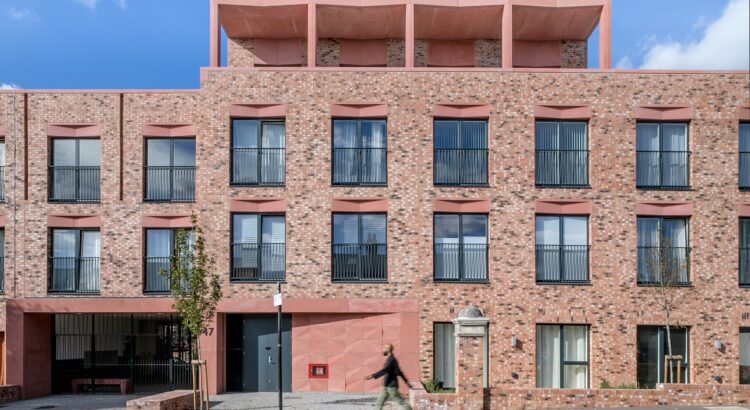A blog by Hugo Owen, Marketing and Communications Executive
Have you ever wanted to understand what theories go into making a great place?
Most of us look at buildings and instinctively understand whether or not we like them. But when asked exactly what it is about the place that we like, it is sometimes harder to explain.
At Pocket Living, our design team has many years of experience in understanding exactly what it is that helps elevate our built environments. In this blog, I will outline a few simple design features that we tend to make great places.
Engaging facades
Whatever the architectural style, everyone has their preferences; what really matters is whether the building, particularly its façade, is engaging.
The evidence is clear on this: engaging façades can bring a range of benefits, from increasing happiness to improving neighbourliness.
To be engaging depends on a number of things, from material use through to ornamental design features. But the traditional preconception is that engaging means complex. This is wrong. In examples that are too complex, our brains struggle to process them. However, when too plain, our brains will inevitably get bored. Just as the tale of Goldilocks tells us, somewhere in the middle is perfect.
We use a range of materials and features to create engaging façades. From our use of elegant frames at Gardner Close E11, to our sleek use of high quality brick at Varcoe Road SE16, the simple design features that elevate our buildings, creating texture and depth, make people take a second look.
Did you know: Active façades are even proven to have a great effect on our general behaviour. For example, in a research project in America, two identical experiments were undertaken for ‘lost tourists’: one in front of an ‘inactive’ blank warehouse building and the other outside an ‘active’ façade with various small businesses and engaging features.
The results were remarkable. Pedestrians at the ‘active’ façade site were nearly five times more likely to offer assistance than those at the ‘inactive site’, highlighting just how important the environment around us is at affecting our general behaviour.

Our award winning Gardner Close E11 scheme
Enclosed spaces
We have developed as a species to prefer enclosed spaces (to a point). While we no longer face the threat that our ancestors once did, the evidence tells us that we still prefer a sense of enclosure. This is reflected in the urban spaces we design.
Think about it this way – what is the nicest urban space you like to spend time in? Places that spring to mind are the Georgian and Victorian squares dotted around London. These open spaces are enclosed by gentle buildings that are not overwhelming in their height, encouraging people from all across London to come, sit and relax.
But a sense of enclosure can come from other means too. Good and clever greenery, from trees to shrubs, can be just as effective in creating a relaxing place.
Many of our developments are designed around a central courtyard, like Gainsford Road E17, Gardner Close E11 or the future Forest Road E17. At West Green Place N17, we have designed a centrally enclosed avenue that has encouraged neighbourliness and provided a relaxing place to spend time in.

Streets for people
The design of our urban environments since the 1920’s has been inexplicitly linked to the development of the car. It has become somewhat second nature to assume the car sits at the top of the street hierarchy, and this has been reflected in modern day design. As a result of this, the idea of children playing on the street is almost a thing of the past.
We create places where the pedestrian sits on top of this hierarchy. As our developments are often located close to public transport links, we try, where we can, to design for minimal car use. Not only does this reduce the carbon footprint of our developments, but it helps create nicer places.
We can do this in a few simple ways. Take West Green Place N17 – rather than using a sea of asphalt, we have used more humanising materials, such as paving sets. This not only adds to the character of the area but also requires less maintenance and allows for better natural drainage. Dropped curves have also been used, levelling out the pavement and the highway and creating a shared space where cars are guests and children are more inclined to play.
Did you know: Streets that are less associated with the car are proven to increase social connectivity and neighbourliness in residential areas. In a study undertaken in San Francisco, identical studies were carried out on three different streets, varying only in the levels of vehicle traffic. This factor was found to have a great bearing on social connectivity (see table).
The researchers noted when analysing lightly trafficked streets: ‘Front steps were used for sitting and chatting, sidewalks by children for playing, and by adults for standing and passing the time of day’. However, the heavy street had ‘little or no sidewalk activity and was used solely as a corridor between the sanctuary of individual homes and the outside world. Residents kept very much to themselves so there was no feeling of community at all.’

Places should be designed for people to love and cherish. Those that are inevitably stand the test of time. In the words of John Ruskin, ‘When we build, let us think that we build forever’.
Learn more about our developments and what we do.



Thank you for sharing in your post how you design places; use a range of materials and features to create engaging façades. We are planning to hire a home architecture design service to help us design and build our dream house soon. My husband and I finally agreed that we should start the house construction next year.